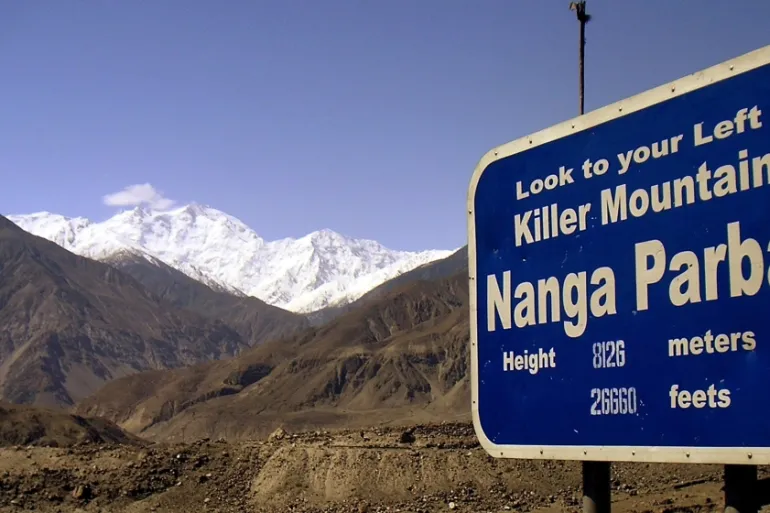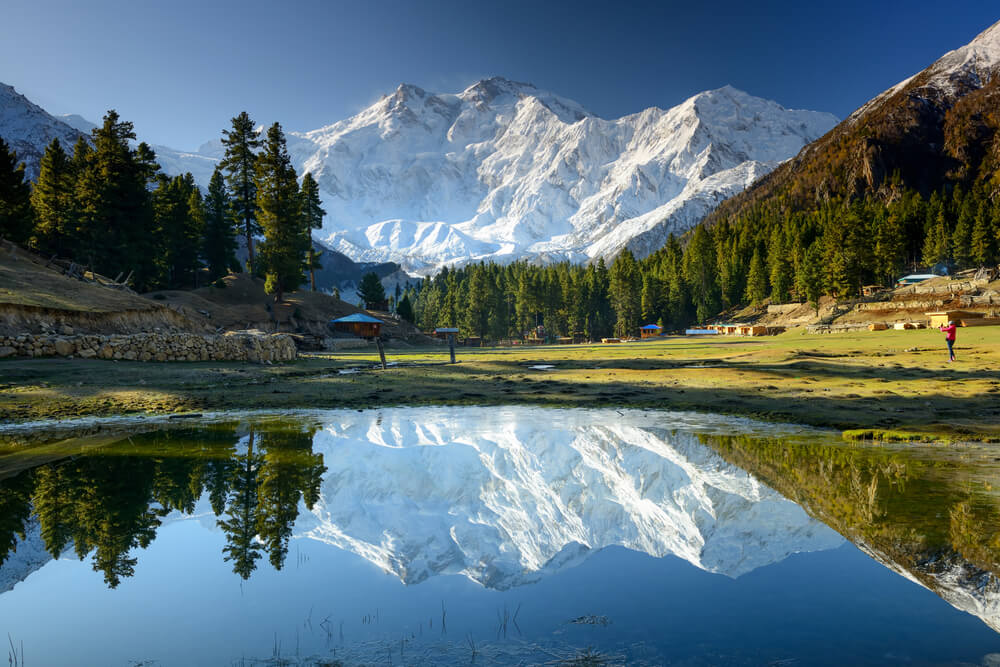Nanga Parbat, the ninth-highest peak in the world, is a majestic mountain that has captivated the imagination of mountaineers and adventurers for centuries. Renowned for its breathtaking beauty, storied past, and formidable challenges, Nanga Parbat beckons those seeking an unforgettable experience.
In this blog post, Graana.com will provide a comprehensive overview of Nanga Parbat, covering its geographical significance, cultural importance, historical expeditions, and adventure opportunities.
Overview of Nanga Parbat

Situated in Astore Valley Pakistan’s Gilgit-Baltistan region, Nanga Parbat stands tall at an elevation of 8,126 metres (26,660 feet), ranking as the world’s ninth-highest peak. Translated as “Naked Mountain” in Urdu, its name reflects the rugged and barren nature of its slopes. The mountain’s challenging terrain and towering prominence have contributed to its reputation as one of the most difficult peaks for climbers.
Notable Features
Nanga Parbat boasts significant vertical relief over the local terrain in all directions, earning its place among the world’s most prominent peaks. Its southern Rupal Face is renowned as the highest mountain face globally, soaring an impressive 4,600 metres (15,090 feet) from its base.
In contrast, the northern Rakhiot Flank presents a complex yet less steep ascent, rising an astounding 7,000 metres (23,000 feet) from the Indus River valley to the summit in a mere 25 kilometres (16 miles), ranking among the planet’s ten most remarkable elevation gains over such a short distance.
Nanga Parbat is one of only two peaks worldwide that rank among the top twenty highest mountains and the most prominent peaks globally, securing the ninth and fourteenth positions, respectively. The other peak sharing this distinction is the renowned Mount Everest, which claims the top spot on both lists.
Additionally, the mountain stands as the second most prominent peak in the Himalayas, second only to Mount Everest. Its pivotal location, with the key col at Zoji La in the Kashmir Valley, connects it to higher peaks within the Himalaya-Karakoram range.
Situated on the Tibetan Plateau, Nanga Parbat marks the easternmost peak of the Himalayas, while Namcha Barwa denotes the eastern end of this majestic mountain range.
Cultural and Geographical Significance
Embraced by the towering Karakoram and Himalayan ranges, Nanga Parbat displays stunning natural beauty and geological variation. The area is renowned for its deep valleys, rough terrains, and untouched glaciers, which have influenced the distinctive plant and animal life found in the vicinity.
This huge mountain also holds significant cultural importance. Local communities hold the mountain in high regard and consider it a sacred site. The neighbouring villages are home to various ethnic groups, such as the Balti, Dardic, and Shina people, each preserving their unique customs and stories.
Tragic Events and Historical Expeditions
Nanga Parbat has a rich history of mountaineering expeditions characterised by both successes and tragedies. The initial documented endeavour to scale the mountain dates back to 1895, led by Albert F. Mummery and his team. Nevertheless, it wasn’t until 1953 that Austrian climber Hermann Buhl finally conquered the summit.
Regrettably, the mountain has been the site of numerous mountaineering fatalities, earning its ominous reputation. One of the most harrowing incidents occurred during the 1937 German-American expedition led by Willy Merkl, resulting in the loss of nine climbers during a fierce storm. These occurrences have contributed to the mountain’s allure and the enigmatic aura surrounding it.
Adventure and Trekking

For those seeking a less technically challenging experience, Nanga Parbat offers mesmerising trekking opportunities. The Rupal Valley Trek and the Fairy Meadows Trek are favoured options, offering awe-inspiring vistas of the mountain and the surrounding landscapes. These treks enable visitors to fully immerse themselves in the natural splendour of the region while enjoying the warm hospitality of the local communities.
Adventure tourism in the Nanga Parbat area is gaining traction, with activities like paragliding, rock climbing, and camping enticing thrill-seekers from various corners of the globe. The Karakoram Highway, renowned as the “Eighth Wonder of the World,” presents a picturesque and adventurous road trip route for accessing the base of the mountain.
Climbing Routes
Nanga Parbat presents a range of climbing paths, each offering its own set of obstacles and achievements. Among these, the Diamir Face and the Rakhiot Face stand out as the most popular choices. The Diamir Face also referred to as the “Normal Route,” is favoured for its comparatively safer and less technically challenging climb. In contrast, the Rakhiot Face presents greater difficulties, with perilous icefalls, rockfalls, and steep inclines.
Moreover, scaling this mountain demands advanced mountaineering expertise, physical endurance, and adaptation to high altitudes. Climbers should anticipate harsh weather conditions, including extreme cold, strong winds, and frequent snowstorms, intensifying the challenges of the ascent.
Nearby Peaks
Following are the nearby peaks of Nanga Parbat:
- Rakhiot Peak
- Chongra Peak
- Mazeno Peak
- Rupal Peak
- Laila Peak (Rupal Valley)
- Shaigiri
Rakhiot Peak
Rakhiot Peak is a 7,070-metre mountain located in the Himalayas in the Gilgit-Baltistan region of Pakistan. It is one of the six peaks that surround Nanga Parbat, the ninth-highest mountain in the world. Rakhiot Peak is a technically challenging mountain to climb, and it has only been summited a handful of times. The first successful ascent of Rakhiot Peak was in 1977 by a Japanese expedition.
Chongra Peak
Chongra Peak is a 6,893-metre mountain located in the Himalayas. It is another one of the six peaks that surround the mountain. Chongra Peak is a less technically challenging mountain to climb than Rakhiot Peak, and it is more popular with climbers. The first successful ascent of Chongra Peak was in 1966 by a German expedition.
Mazeno Peak
Mazeno Peak is a 6,610-metre mountain and the third of the six peaks surrounding Nanga Parbat. This peak is a popular mountain with climbers, and it is often climbed as part of an acclimatisation process for climbing the mountain. The first successful ascent of Mazeno Peak was in 1957 by an Austrian expedition.
Rupal Peak
Rupal Peak is a 5,642-metre mountain and is located just south of the mountain. This peak is a relatively easy mountain to climb, and climbers often climb it as they acclimatise for higher local peaks. The first successful ascent of Rupal Peak was in 1964.
Laila Peak (Rupal Valley)
Laila Peak is a 5,971-metre mountain located in the Himalayas in the Gilgit-Baltistan region of Pakistan. It is located to the southwest of Nanga Parbat. Laila Peak is a more challenging mountain to climb than Rupal Peak, but it is still less technically challenging than Rakhiot Peak or Chongra Peak. The first successful ascent of Laila Peak was in 1970.
Shaigiri
Shaigiri is a 5,690-metre mountain located in the Himalayas in the Gilgit-Baltistan region of Pakistan. It is located just west of Nanga Parbat. Shaigiri is a popular mountain with trekkers and mountaineers, and it is often climbed as part of a trek to Nanga Parbat Base Camp. The first successful ascent of Shaigiri was in 1978.
All of these peaks offer stunning views of Nanga Parbat and the surrounding Himalayas. They are all challenging to climb, but they are all rewarding experiences for climbers and trekkers alike.
Conclusion
Nanga Parbat, renowned for its breathtaking beauty, storied past, and formidable obstacles, continues to attract mountaineers and adventurers seeking an unforgettable experience. This magnificent peak perfectly combines natural magnificence, cultural variety, and exhilarating escapades. Whether you aspire to conquer its summit or simply revel in its scenic marvels, a journey to this mountain promises to leave an enduring impression on your spirit.
As you prepare for your expedition or trek, you must honour the mountain, adhere to safety measures, and interact respectfully with the local communities. Nanga Parbat beckons, ready to unveil its grandeur to those brave enough to embrace its majestic charm.
Frequently Asked Questions (FAQs)
Following are the most common questions and their answers about Nanga Parbat.
Q: Where is Nanga Parbat located?
A: Nanga Parbat is situated in the Gilgit-Baltistan region of Pakistan.
Q: What is the elevation of Nanga Parbat?
A: The elevation of Nanga Parbat is 8,126 metres (26,660 feet), making it the ninth-highest peak globally.
Q: What is the meaning of the name “Nanga Parbat”?
A: “Nanga Parbat” translates to “Naked Mountain” in Urdu, reflecting its slopes’ bare and steep nature.
Q: What are the popular climbing routes on Nanga Parbat?
A: The popular climbing routes on Nanga Parbat include the Diamir Face and the Rakhiot Face.
Q: What is the cultural significance of Nanga Parbat?
A: This mountain holds cultural significance for local communities and is considered sacred by the region’s indigenous people.
Q: What are the trekking opportunities near Nanga Parbat?
A: Popular trekking opportunities near Nanga Parbat include the Rupal Valley Trek and the Fairy Meadows Trek.
Q: What is the history of mountaineering expeditions on Nanga Parbat?
A: Nanga Parbat has a history of both triumphs and tragedies in mountaineering, with notable expeditions dating back to the late 19th century.
Q: What are the challenges that climbers face on Nanga Parbat?
A: Climbers on the mountain encounter challenges such as extreme weather conditions, treacherous terrain, and high altitude risks.
Q: What adventure activities can be enjoyed near Nanga Parbat?
A: Adventure activities near the mountain include paragliding, rock climbing, and camping.
Q: What safety precautions should be taken while exploring Nanga Parbat?
A: Safety precautions while exploring the mountain include respecting the mountain, following safety protocols, and being responsible towards the local communities.
For more related information, visit Graana Blog.




